Standard Fire Protection
Main Underground Piping
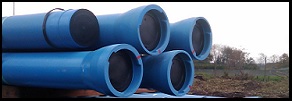 We design systems consisting of multiple loops and multiple water supplies with a network of underground and above ground piping throughout the plant pressurized with water using fire pumps who are connected to a reliable water source. Providing hydrants/water monitors at strategic locations, alarm valves with sprinklers, deluge valves and or / pre-action valves. Fire water underground distribution systems often fall into the category of unseen and forgotten. With the requirements of NFPA 25, including inspection, testing and maintenance activities of the visible portions of the fire water supply and distribution system, such as fire pumps, fire hydrants, monitors, piv’s, and fixed water-based fire suppression systems served by the fire water system, we also insist that these types of preventive maintenance activities are being applied to the underground mains.
We design systems consisting of multiple loops and multiple water supplies with a network of underground and above ground piping throughout the plant pressurized with water using fire pumps who are connected to a reliable water source. Providing hydrants/water monitors at strategic locations, alarm valves with sprinklers, deluge valves and or / pre-action valves. Fire water underground distribution systems often fall into the category of unseen and forgotten. With the requirements of NFPA 25, including inspection, testing and maintenance activities of the visible portions of the fire water supply and distribution system, such as fire pumps, fire hydrants, monitors, piv’s, and fixed water-based fire suppression systems served by the fire water system, we also insist that these types of preventive maintenance activities are being applied to the underground mains.
Fire Pump Rooms
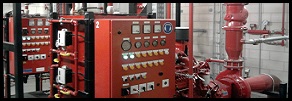 Fire pumps are often a forgotten element of an automatic fire protection system, none of the less it is the heart of the fire protection system. If a fire pump doesn't work, the entire system may fail with catastrophic results. Ingenial gives you a detailed insight on the various components of a pump assembly, pump driver and controller and find out about the inspections and tests from the weekly start and run the annual flow test with the local authority having jurisdiction. We will learn you how to compare pump curves from annual tests to spot deterioration in pump performance. All according to the specific rules about fire pump rooms.
Fire pumps are often a forgotten element of an automatic fire protection system, none of the less it is the heart of the fire protection system. If a fire pump doesn't work, the entire system may fail with catastrophic results. Ingenial gives you a detailed insight on the various components of a pump assembly, pump driver and controller and find out about the inspections and tests from the weekly start and run the annual flow test with the local authority having jurisdiction. We will learn you how to compare pump curves from annual tests to spot deterioration in pump performance. All according to the specific rules about fire pump rooms.
Fire Water Supplies - Tanks
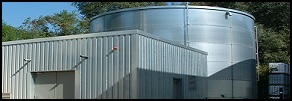 We build individually engineered tanks to serve as water reservoirs for fire protection applications. A fire protection tank can be manufactured according to NFPA-22, Factory Mutual (FM), LPCB (UK) and European standards.
Factory-galvanized bolted steel tanks provide an economical and long lasting solution for fire protection water storage. The modular bolted design makes it possible for swift and easy installation in an assortment of weather conditions and requires no welding or field coating. Fire protection tanks can also be installed under-roof if necessary. Common accessories such as tank insulation, ladders, level indicators, access ports, platforms and walkways can also be provided.
Our products are custom designed to meet site conditions, volume requirements and aesthetic needs. These storage solutions range from standard fire protection tanks to highly sophisticated reservoirs and multi-tank configurations.
We build individually engineered tanks to serve as water reservoirs for fire protection applications. A fire protection tank can be manufactured according to NFPA-22, Factory Mutual (FM), LPCB (UK) and European standards.
Factory-galvanized bolted steel tanks provide an economical and long lasting solution for fire protection water storage. The modular bolted design makes it possible for swift and easy installation in an assortment of weather conditions and requires no welding or field coating. Fire protection tanks can also be installed under-roof if necessary. Common accessories such as tank insulation, ladders, level indicators, access ports, platforms and walkways can also be provided.
Our products are custom designed to meet site conditions, volume requirements and aesthetic needs. These storage solutions range from standard fire protection tanks to highly sophisticated reservoirs and multi-tank configurations.
Traditional Sprinkler Protection
(All Hazards)
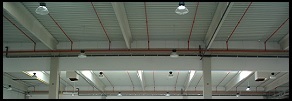
Automatic fire sprinklers operate at a predetermined temperature, utilizing a fusible element or a glass bulb. When activated the plug in the orifice will be pushed out of the orifice by the water pressure in the fire sprinkler piping, resulting in water flow from the orifice. The water stream impacts a deflector, which produces a specific spray pattern designed in support of the goals of the sprinkler type. The majority of automatic fire sprinklers operate individually in a fire.
The main extinguishing effect of water is based on its heat –absorbing ability. The cooling effect interrupts heat development and prevents the evaporation of combustibles by wetting combustible materials. Water extinguishes fires by cooling and prevents ignition of unburned materials.
Special Sprinkler Protection (Storage, CMSA, CMDA)
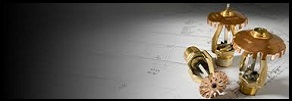
While standard sprinklers offer fire "control" of warehouse fires, ESFR sprinklers are meant to actually extinguish the fire. Standard sprinklers confine a fire by pre-wetting combustibles surrounding the area of the fire and by cooling hot gases at the ceiling. ESFR sprinklers are highly-sensitive to heat much more so than standard sprinklers, so they activate at an earlier stage in fire development. Moreover, they discharge a large volume of water at high momentum directly into and through the fire plume. The ESFR's deflector produces a broad spray pattern to control fire between sprinklers, while the orifice maintains a high-force downward to penetrate and suppress fire directly below. Building height may increase without the need of in racks sprinklers, within the limits of the sprinkler.
Sprinkler Protection in Racks & High Bay Storage
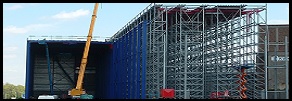
Warehouse fires spread quickly and have immense increases in heat release rate over a short period of time. This is especially true when the fire involves commodities such as flammable liquids, paper, and exposed plastics. Fire sprinklers represent an important development in the fight against warehouse fires. Nonetheless, their performance can be compromised if codes and design guidelines are not closely followed. We offer the ultimate in fire protection for the warehouse, its contents, and the people who work there. Another strong capability is creation of warehouse sprinkler systems that not only meet required codes for the stored materials, but will also permit flexibility in storage height, arrangements. Look to us for innovative solutions to your warehouse & storage fire protection needs.
Deluge Fire Protection Systems
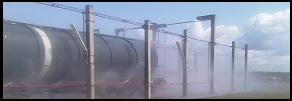
Invariably the oil, gas, chemical, pharmaceutical and power industries present a number of special hazards which warrant individual consideration. Our experience in the design and installation of automatic and manually operated water spray installations allows these hazards to be given maximum protection utilising the most effective equipment currently available to meet the specific risk requirements.
Low, medium and high velocity deluge systems can be installed according to the needs of the object to be protected.
Residential Sprinkler Protection
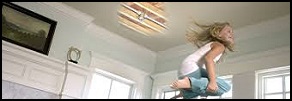 Residential sprinklers are devices to attack a fire in its early stages by spraying enough water to put out the fire or keep it from spreading. These sprinkler heads operate quickly to minimize the threat from heat, flames and toxic smoke.
Residential sprinklers are devices to attack a fire in its early stages by spraying enough water to put out the fire or keep it from spreading. These sprinkler heads operate quickly to minimize the threat from heat, flames and toxic smoke.
The applicatiion is foreseen in houses, apartments, mobile homes, hotels, motels, dormitories, care centers, etc. Residential sprinkler systems use lightweight, inexpensive piping and fittings of plastic, copper or thin-wall steel in place of traditional materials. Their "quick response" opens faster than those in industrial and commercial properties and operate from the household water supply. These sprinkler systems can be built into new housing or added to existing buildings. It is estimated that residential sprinkler systems
would add only about one to one and a half percent to the cost of new housing.
Hose Reels & Extinghuisers
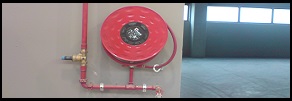 Fire hose reel stations provide the first line of defense against fire so they are positioned throughout a building. Long before temperatures become sufficiently high to activate the fire sprinkler system, fire hose reel stations can provide rapid fire suppression before combustion reaches life threatening levels.
Fire hose reel stations provide the first line of defense against fire so they are positioned throughout a building. Long before temperatures become sufficiently high to activate the fire sprinkler system, fire hose reel stations can provide rapid fire suppression before combustion reaches life threatening levels.
In the beginning all large fires were small. And with a fire extinguisher they might have been prevented. We provide the corresponding extinguisher for all ranges of application and all fire classifications. One thing must be clear from the beginning: the operation of a fire extinguisher, in case of emergency nobody will be in the position to think twice. The two most common types of extinguishers pressurized dry chemical (Type BC or ABC) and carbon dioxide extinguishers (CO2). Other types can be utilized according to the specific needs, please contact us for more details.
Fire Detection & Alarm Systems
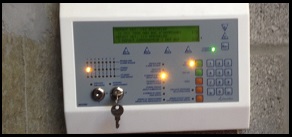 The MD2400 analogue addressable fire alarm control panel has been designed according to the European Standards EN-54 in combination with the Apollo XP95 range of fire detectors and alarm devices.
The MD2400 control panel is composed of an elegant operator console with LCD display, serially connected to the fire alarm control panel in a separate metal housing (black-box). This serial bus allows the remote connection of 8 operator consoles with LCD display, 8 repeater panels, 8 printers and 15 relay modules.
The MD2400 operator console with LCD display allows to display the system data and the different alarm and fault announcements and is equipped with membrane switch controls to operate the control panel and to set up some system parameters.
The fire control panel has a maximum capacity of 16 loops and can be extended unlimitedly by means of the MD2400 token bus network and the corresponding master/slave configuration. A maximum of 126 Apollo XP95 fire detectors and alarm devices can be connected to one loop interface card. An optional user interface for computer (graphics software) is available. The communication between the MD2400 control panel and the computer can be realized locally or via internet.
The possibility to send the alarm- and fault information via SMS and the possibility to link the MD2400 main fire control panel with a paging system by using the ESPA 4.4.4. Protocol is also available.
The MD2400 analogue addressable fire alarm control panel has been designed according to the European Standards EN-54 in combination with the Apollo XP95 range of fire detectors and alarm devices.
The MD2400 control panel is composed of an elegant operator console with LCD display, serially connected to the fire alarm control panel in a separate metal housing (black-box). This serial bus allows the remote connection of 8 operator consoles with LCD display, 8 repeater panels, 8 printers and 15 relay modules.
The MD2400 operator console with LCD display allows to display the system data and the different alarm and fault announcements and is equipped with membrane switch controls to operate the control panel and to set up some system parameters.
The fire control panel has a maximum capacity of 16 loops and can be extended unlimitedly by means of the MD2400 token bus network and the corresponding master/slave configuration. A maximum of 126 Apollo XP95 fire detectors and alarm devices can be connected to one loop interface card. An optional user interface for computer (graphics software) is available. The communication between the MD2400 control panel and the computer can be realized locally or via internet.
The possibility to send the alarm- and fault information via SMS and the possibility to link the MD2400 main fire control panel with a paging system by using the ESPA 4.4.4. Protocol is also available.
ARGON - Gas Extinguishing
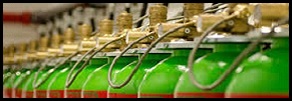 The "total flooding" extinguishing system called Argonfire uses a gas present in the air, "argon". Argon is a pure gas, it is not a mixture, in time it does not stratify, it allows an excellent visibility during the discharge with a uniform flooding and a long term concentration in the protected area. Argonfire is environmentally safe (zero-ozone-depletion, zero-global warming - potential) and its use, contrary to the chemical gases, is indetermined in time. Argon is electrical non - conductive, clean, ecologic, it is effective in protecting goods and, at high temperature, it does not produce products of decomposition harmful for people's safety. Argon suppresses fires reducing the oxygen concentration in the air; therefore, it is necessary to avoid, to get an effective suppression, the outlet of the fire extinguishant from the protected area.
The "total flooding" extinguishing system called Argonfire uses a gas present in the air, "argon". Argon is a pure gas, it is not a mixture, in time it does not stratify, it allows an excellent visibility during the discharge with a uniform flooding and a long term concentration in the protected area. Argonfire is environmentally safe (zero-ozone-depletion, zero-global warming - potential) and its use, contrary to the chemical gases, is indetermined in time. Argon is electrical non - conductive, clean, ecologic, it is effective in protecting goods and, at high temperature, it does not produce products of decomposition harmful for people's safety. Argon suppresses fires reducing the oxygen concentration in the air; therefore, it is necessary to avoid, to get an effective suppression, the outlet of the fire extinguishant from the protected area.
The system uses great capacity cylinders that make the installation economic and compact.The cylinders are 80 and 140 litres and have the retesting every 10 years. Argonefire cylinders can be placed at great distance and, using the selector valves, convenience and flexibility are guaranteed.
CO2 - Gas Extinguishing
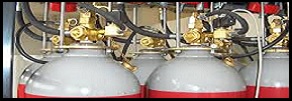 Prior to the Montreal Protocol in the late 1980s, Halon was considered the best agent for extinguishing fires. In the Montreal Protocol, however, great concern was expressed regarding the effects of CFS and Halons on the ozone layer. This influenced the decision that Halon should be replaced and eliminated. Search and investigation for new and effective means of extinguishment resulted in the appearance of a wide range of alternative extinguishing agents, such as clean gases, inert gases and C02.
CO2 is suitable for unoccupied areas, as the agent is hazardous to humans at the concentrations required to extinguish fires.
Prior to the Montreal Protocol in the late 1980s, Halon was considered the best agent for extinguishing fires. In the Montreal Protocol, however, great concern was expressed regarding the effects of CFS and Halons on the ozone layer. This influenced the decision that Halon should be replaced and eliminated. Search and investigation for new and effective means of extinguishment resulted in the appearance of a wide range of alternative extinguishing agents, such as clean gases, inert gases and C02.
CO2 is suitable for unoccupied areas, as the agent is hazardous to humans at the concentrations required to extinguish fires.
CO2 is discharged into an enclosure or directly onto the surface requiring protection, and reduces the oxygen level to below that which can support combustion. It creates a cooling effect on the fire and surrounding area. CO2 is stored as a liquid in a cylinder or bulk tank. It has been applied efficiently for more than 50 years in more than 100,000 areas (transformers, archives, electrical hazards, etc.).
Services
Solutions
Quality & Certifications
- » BOSEC - ISO 9001:2015 - VCA PETRO
- » NFPA Member
- » BFSN Member
- » Quell Authorized Dealer
- » Cold Store Service Partner
- » EconAqua & ULF Mist Systems Dealer
